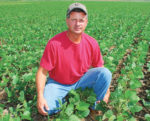Advertise Follow Us
Articles Tagged with ''fertility''
A commitment to strip-till and ongoing nitrogen application trials and timing reward Illinois strip-tillers Dan and Trent Sanderson
Read More
No-Till Practices Yield ‘Win-Win’ For Nutrient Use
No-tillers honored as Responsible Nutrient Management Practitioners share how data management, cover crops, split applications and tissue testing helped them increase yields more efficiently.
Read More
Fertility, Covers, Precision Inputs Form Complete No-Till Package
Bill Murr leverages the soil-building benefits of no-till with strategic nutrient, weed and disease management on his 3,400-acre farm in northeast Kansas.
Read More
Cover Crop Enthusiasm Helps No-Tiller Get More With Less
Spurred on by a payoff in soil quality and reduced inputs, Missouri no-tiller Bruce Bartlett is overcoming cover-crop challenges to improve his no-till system.
Read More
Emerging Biologicals Could Help No-Tillers Get More With Less
Bio-ag products are outgrowing their “snake oil” reputation and could bring higher yields at a lower environmental price.
Read More










